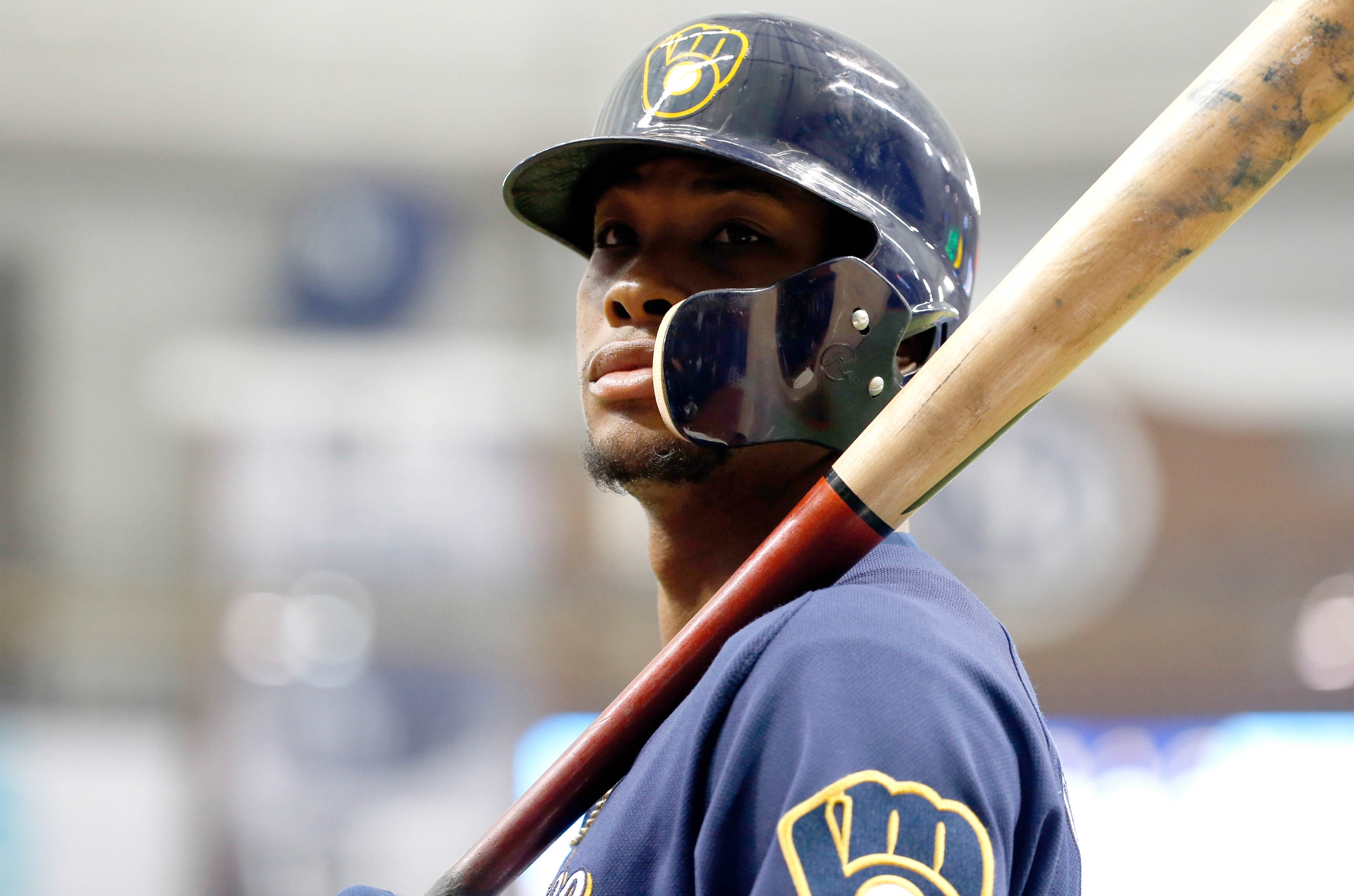Two weeks ago, I wrote about how the slow free agent market will cut into the Brewers’ ability to make trades to address their second base hole if they don’t re-sign Neil Walker. In those two weeks, basically nothing has happened. There have been rumors that the Brewers were close to a substantive trade, but nothing has materialized. An offer has reportedly been made to Yu Darvish, but he has not yet agreed to sign anywhere. Instead, we are two weeks closer to pitchers and catchers reporting (now just over two weeks away), and there has still not been any substantial player movement this offseason.
Relevantly, this includes the Brewers, who have not addressed their complicated outfield situation. Last year, the outfield rotation was pretty well established. Ryan Braun played left field, Domingo Santana played right field, and Keon Broxton split time with a few other players in center field. Heading into 2018, though, the calculus was expected to be different. One of those players that got a small portion of the center field at bats was Lewis Brinson, who is the club’s consensus top prospect and is at the point of his career where he needs major league at bats to continue his development.
Brinson is not the only youngster fighting for playing time, though. Brett Phillips also performed well last year in minimal playing time (.293 TAv, 4.3 FRAA in 37 games), and he appears to be a capable like-for-like replacement for Broxton. And given that Phillips’ prospect pedigree (Baseball America ranked him 80th in all of baseball this offseason), he likely has a higher ceiling than Broxton, thus incentivizing the club to prioritize Phillips ahead of Broxton. Additionally, Hernan Perez and Jonathan Villar both got some playing time in the outfield last season, and the fact that they can play both infield and outfield increases their value because they are more versatile than is Broxton.
For these reasons, a common thought at the beginning of the offseason was that the Brewers would look to trade one of their outfielders. Santana was a possible trade chip, as he now has a track record of being a productive big league hitter, and he is probably be the most attractive non-Brinson asset that the Brewers could dangle to bring back a front-line pitcher. If Santana were to be dealt, Broxton could serve as a fourth outfielder and platoon with Phillips in left field. He would also provide Brinson insurance in case something went wrong with the club’s top prospect.
If the Brewers decided to keep Santana, though, Broxton himself could have been a trade chip. He was not so productive last year that the club could not replace him, and Phillips appears ready to step in and be the fourth outfielder. A Broxton trade is trickier than a Santana trade because Broxton’s trade value as a cost-controlled role player is harder to determine, but it was nonetheless a possibility if the Brewers needed a way to address their roster logjam.
Three months into the offseason, though, nothing has been done to address this issue. The slowness of the free agent market appears to have impacted the trade market as well; Gerrit Cole is the only pitcher of note to have changed teams this offseason, so Santana could still be included in a trade (for Chris Archer, for example). The Brewers have therefore been hesitant to commit to a particular path, as trading Santana might encourage them to keep Broxton.
One might think that if Broxton is replaceable, then they should simply deal him and get a replacement if they also trade Santana. As mentioned above, however, it’s unclear whether Broxton has much trade value. He is still in his pre-arb years, but he is already 27 and so he isn’t a highly touted prospect who teams will be clamoring to get for the next four seasons. He has accumulated 2.3 WARP in 700 plate appearances, which makes him a roughly league average player but not a standout. He is therefore a valuable player to have on a big league roster, but he is not likely to be the type of player who returns a lot in a trade. He may therefore be more valuable to the Brewers on the field (if they need him) than he would be to another team.
The Brewers’ front office is smart and capable of dealing with this problem, and they have shown they are not afraid to lose players for nothing even if there might still be some residual value. It is here where the slowness of the market comes into play, however. If a Santana trade happened or were ruled out in December, the Brewers would have had a couple months to figure out how to best use Broxton’s roster spot (whether it be on Broxton or on someone else). Now, however, they are in a time crunch.
If they have decided that they will be keeping Santana, then Broxton is basically expendable. And if they decided that in December because they had passed on all the potential deals, they would have had two months of watching the waiver wire to find players who were a better fit for their roster than Broxton. I do not believe they have made that determination yet, though, so their roster is still in flux.
As I wrote two weeks ago about the second base situation, this is not an insurmountable problem. It is, however, a way that the slowness of the market impacts the clubs beyond just delaying any roster decisions. The Brewers will have less time to assess their options, and any potential waiver wire acquisitions may be more contested as teams are looking to finalize their rosters heading into spring training.
Photo Credit: Kim Klement, USAToday Sports Images
